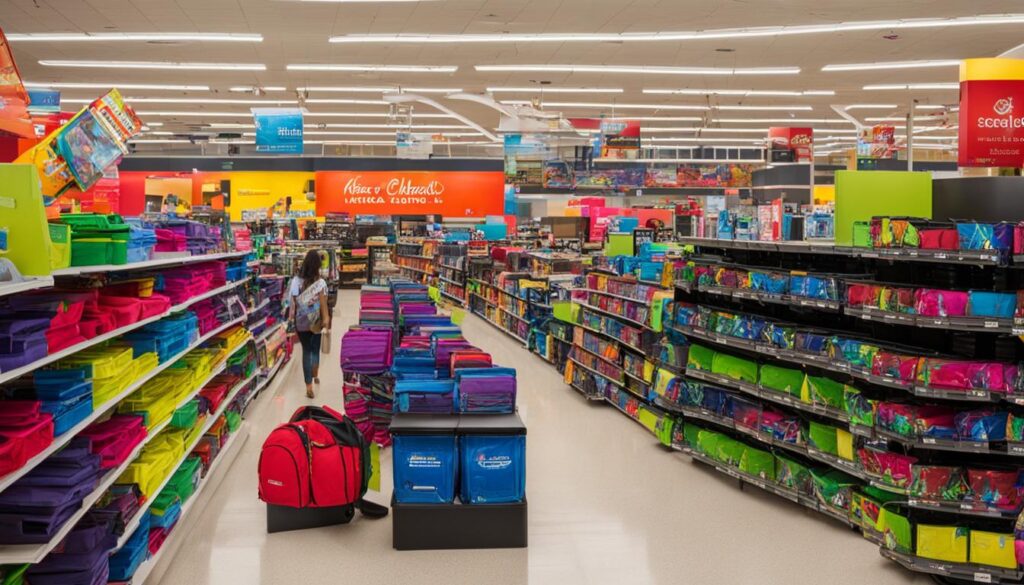The back-to-school season is an exciting time for students, but it can also be a stressful period for parents who need to manage their finances wisely. From school supplies to tuition fees, there are many expenses to consider. In this comprehensive guide, we will provide you with valuable tips and tricks to create a back-to-school budget that will ensure a smooth and financially sound start to the school year.
Key Takeaways:
- Creating a back-to-school budget is crucial for managing your finances during this expensive period.
- Take stock of existing supplies before making new purchases to avoid unnecessary expenses.
- Consider balancing brand name products with basic supplies to save money without compromising quality.
- Collaborating with other parents can be a cost-effective solution, allowing you to share supplies and reduce waste.
- Timing your purchases strategically can help you take advantage of back-to-school sales and discounts.
Top Back-to-School Budgeting Tips
When it comes to back-to-school shopping, it’s important for parents to create a budget to help manage their expenses. Source 1 provides some practical back-to-school budgeting tips for parents that can make a significant difference. One of the first steps is determining your child’s budget. By setting a specific amount, you can avoid overspending and ensure that you stay within your financial limits.
Another helpful tip is to set spending limits for different categories. Assess what items are really needed and prioritize those purchases. Developing a shopping list can help you stay organized and avoid impulsive buying. It’s also worth taking advantage of tax-free weekends, which can provide additional savings on certain items.
One important aspect of budgeting is involving your child in the process. By teaching them about needs versus wants, you can help them understand how to make responsible spending choices. This educational opportunity can set them up for financial success in the future.
Table: Price Comparison for Common Back-to-School Items
| Item | Retail Store | Price |
|---|---|---|
| Backpack | Store A | $30 |
| Backpack | Store B | $25 |
| Backpack | Store C | $22 |
| Notebook | Store A | $2 |
| Notebook | Store B | $1.50 |
| Notebook | Store C | $1 |
Above is a price comparison table for common back-to-school items. As you can see, Store C offers the most affordable options for backpacks and notebooks, allowing you to get the best value for your money. Comparing prices across different retailers can help you make informed decisions and save money in the process.
Take Stock of Existing Supplies
Before rushing to buy new back-to-school supplies, it’s a wise move to take stock of what you already have at home. Many times, children don’t use up all of their supplies from the previous school year, and some items may still be in good condition. By assessing the existing supplies, you can save money by avoiding unnecessary purchases and reduce waste.
Creating a checklist of the items you already have can help you determine what you truly need for the upcoming school year. Check if there are any reusable notebooks, partially used pencils, or still-fitting clothing items that can be used again. This way, you can prioritize purchasing only the essential items and allocate your budget more efficiently.
By taking stock of existing supplies, you not only save money but also teach your children the importance of resourcefulness and sustainability. It’s a valuable lesson for them to learn early on, as it encourages mindful consumption and reduces unnecessary waste.
Table: Items to Check for Existing Supplies
| Category | Items to Check |
|---|---|
| Writing Materials | Pencils, pens, erasers, rulers |
| Notebooks and Binders | Partially used notebooks, binders in good condition |
| Clothing | Uniforms, shoes, backpacks |
By going through this checklist and reusing any available items, you can make a significant dent in your back-to-school expenses without compromising on your child’s needs.
Balancing Brand Name and Basic
When it comes to back-to-school shopping, finding a balance between brand name products and basic supplies can help you save money without compromising on quality. While children may be enticed by trendy and expensive items, it’s important to teach them the value of making choices based on functionality and quality rather than brand recognition. By prioritizing basic supplies and considering alternative options, you can create a budget-friendly back-to-school shopping list.
Choosing Quality Over Brand Name
While some brand name products may offer superior quality, it’s not necessary to splurge on every item. For essentials like notebooks, pencils, and binders, opting for generic or store-brand options can be just as functional and durable. By choosing quality over brand name, you can find cost-effective alternatives that meet your child’s needs without breaking the bank.
Exploring Second-Hand Options
Thrift shops and second-hand stores can be a goldmine for back-to-school supplies. You may find gently used backpacks, clothing items, and even technology at a fraction of their original price. Encourage your child to embrace the idea of sustainable shopping and show them that used items can be just as good as new. Not only will you save money, but you’ll also be reducing waste and contributing to a more eco-friendly approach to shopping.
| Brand Name vs. Basic Supplies | Pros | Cons |
|---|---|---|
| Brand Name | – Perceived quality and reputation – Trendier designs and styles | – Higher price point – Potential for overemphasis on brand recognition |
| Basic Supplies | – Cost-effective – Functional and durable | – Less emphasis on trendy designs – Limited brand recognition |
Teaching children about the value of quality over brand name can help instill important financial values and decision-making skills. By encouraging them to prioritize functionality and durability, you are empowering them to make informed choices that will benefit them in the long run.
By balancing brand name products with basic supplies, you can create a back-to-school shopping list that fits your budget while still providing your child with the essentials they need to succeed in the classroom. Remember, it’s not about the label on the supplies, but rather the value they provide. With a little smart shopping and guidance, you can navigate the back-to-school season with confidence and financial savvy.
Collaborate with Other Parents
Collaborating with other parents can be a cost-effective solution for back-to-school shopping. By sharing supplies and trading items with each other, parents can reduce the need to purchase everything individually and save money in the process. This collaborative approach not only helps lighten the financial burden but also fosters a sense of community among parents.
One way to collaborate with other parents is to organize a supply swap event. Parents can gather together and bring any excess school supplies or gently used clothing that their children have outgrown. They can then exchange these items with other parents, ensuring that everyone has what they need without overspending. Such events not only save money but also promote sustainability by reducing waste.
Another way to collaborate is to form a school supplies buying group. Parents can come together and pool their resources to buy supplies in bulk. This strategy allows them to take advantage of bulk discounts and get better deals on essential items like notebooks, pencils, and glue sticks. By working together, parents can secure significant savings and ensure that every child has the necessary supplies for school.

Benefits of Collaboration:
- Cost-effective solution for back-to-school shopping
- Promotes community and fosters relationships among parents
- Reduces waste and promotes sustainability
- Allows access to bulk discounts and better deals
- Ensures every child has the necessary supplies
“Collaborating with other parents not only saves money but also creates a sense of camaraderie and support within the community.” – Parenting Magazine
Timing Your Purchases
When it comes to back-to-school shopping, timing your purchases can be a smart strategy to save money. By taking advantage of back-to-school sales and discounts, you can stretch your budget further and get the most value for your money.
One optimal time to shop for back-to-school supplies is during Labor Day weekend. Many retailers offer significant discounts during this period as part of their back-to-school promotions. It’s a great opportunity to stock up on essential items like notebooks, pencils, and backpacks at lower prices.
“Labor Day weekend is a prime time to score great deals on back-to-school supplies,” says Sarah Thompson, a shopping expert. “Retailers often have special promotions and sales events that can help parents save money while getting their children ready for the new school year.”
Another option is to wait until September when stores often have back-to-school clearance sales. This is when retailers are trying to clear out inventory that hasn’t sold during the earlier part of the season. You can find even deeper discounts on items like clothing, shoes, and electronics during these clearance sales.

Table: Best Times to Shop for Back-to-School Supplies
| Month | Reason |
|---|---|
| August | Back-to-school sales and promotions |
| Labor Day Weekend | Special discounts and deals |
| September | Back-to-school clearance sales |
By strategically timing your back-to-school purchases, you can take advantage of these sales and discounts, enabling you to save money while still getting all the supplies your child needs for the school year.
Teach Financial Skills While Shopping
Back-to-school shopping is not just about buying supplies; it’s also an excellent opportunity to teach children important financial skills. By involving them in the budgeting process and guiding their purchasing decisions, parents can help instill lifelong money management habits. Here are some effective ways to teach financial skills while shopping:
Determine a budget
Start by setting a budget for your child’s back-to-school purchases. Discuss what items are essential and how much money is available. This will teach them the importance of prioritizing needs over wants and help develop their decision-making skills.
Create a shopping list
To avoid impulse buying and overspending, work with your child to create a shopping list. Include only the necessary items within the budget. This will teach them to plan ahead, make thoughtful choices, and stick to a plan.
Quote: “By involving them in the budgeting process and guiding their purchasing decisions, parents can help instill lifelong money management habits.”
Compare prices and look for discounts
Show your child the importance of comparing prices and looking for discounts. Teach them to research different stores and brands to find the best value for money. This will help them develop the habit of being savvy shoppers and make informed purchasing decisions.
Encourage saving
If your child expresses interest in more expensive items, use this as an opportunity to teach them about saving. Help them set a savings goal and discuss ways to achieve it. This will teach them the value of delayed gratification and the importance of saving for future needs and wants.
By implementing these strategies, parents can turn back-to-school shopping into a valuable learning experience. Teaching children financial skills from an early age will set them up for future success and equip them with essential life skills. Remember to be patient, encourage questions, and provide guidance along the way.
Conclusion
Creating a back-to-school budget and saving money can be achievable goals for every family. By following the tips and strategies outlined in this guide, parents can navigate the financial challenges of the back-to-school season with confidence. One effective approach is to start by spring cleaning your budget, reviewing your current expenses and identifying areas where you can cut back. This not only helps free up funds for school supplies and clothes but also instills good budgeting habits that can benefit the family throughout the year. With a clear plan in place, parents can make informed decisions that keep their spending in check while ensuring their children have everything they need for a successful school year.
Start by taking stock of existing supplies, minimizing unnecessary purchases, and reducing waste. Balancing brand name products with basic supplies can help save money without compromising quality. Collaborating with other parents and sharing supplies can further reduce costs and foster a sense of community.
Timing your purchases strategically is another key to saving money. By waiting for sales events and back-to-school clearance sales, you can take advantage of deep discounts and maximize your budget. Additionally, involving your children in the budgeting process and teaching them about financial management can instill valuable skills that will benefit them for years to come.
Remember, the back-to-school season doesn’t have to be a financial burden. With careful planning and smart financial decisions, you can ensure that your family’s back-to-school needs are met while staying within your budget. By prioritizing saving money and teaching your children about financial management, you can set a positive example and empower them to make wise financial choices as they grow.
FAQ
How much money do I need for back-to-school supplies?
The average child needs about $700 for back-to-school supplies, including writing materials, uniforms, and sporting gear.
What are some tips for creating a back-to-school budget?
Some tips for creating a back-to-school budget include determining your child’s budget, setting spending limits, assessing what is needed, developing a shopping list, and taking advantage of tax-free weekends.
Should I check what school supplies are already available at home before purchasing new ones?
Yes, it is recommended to check what items are already available at home. Many children do not use all of their supplies from the previous school year, and some clothing items may still be in good condition. Taking stock of existing supplies can help reduce costs and avoid unnecessary purchases.
What should I prioritize, brand name products or basic supplies?
It is recommended to balance brand name products with basic supplies to save money. Prioritize quality over brand name when purchasing school supplies. While children may want trendy and expensive items, parents can teach them the value of making choices based on quality and functionality rather than brand recognition.
Is there a way to save money by collaborating with other parents?
Yes, collaborating with other parents can be a cost-effective solution for back-to-school shopping. Parents can trade items with each other, reducing the need to purchase everything individually. This can apply to bulk items like glue sticks and pencils. By sharing supplies, parents can save money and reduce waste.
When is the best time to make back-to-school purchases?
Timing your back-to-school purchases can result in significant savings. It is recommended to wait for sales events like Labor Day or back-to-school clearance sales in September. Many stores offer deep discounts during this period to clear out inventory. Additionally, waiting a few weeks into the school year can help identify which items are truly necessary and avoid unnecessary expenses.
Can I teach my child about budgeting while back-to-school shopping?
Absolutely! Back-to-school shopping provides an opportunity to teach children about budgeting and financial skills. Parents can set a budget for their child’s purchases and guide them in making choices based on needs versus wants. This can help children understand the value of money and make informed decisions. It is never too early to introduce children to financial management.
How Can I Budget for Travel Expenses While Still Maintaining My Education Expenses?
When balancing education expenses and travel costs, it’s crucial to create a budget that aligns with your goals. Consider using a cheap travel guide to find affordable destinations, accommodation, and transportation options. Planning in advance and prioritizing your expenditures can help you manage both your educational and travel expenses effectively.

